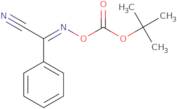Informations sur le produit
- (2-tert-Butoxycarbonyloxyimino)-2-Phenylacetonitrile
- (2E)-{[(tert-butoxycarbonyl)oxy]imino}(phenyl)ethanenitrile
- (2Z)-{[(tert-butoxycarbonyl)oxy]imino}(phenyl)ethanenitrile
- 2-(Boc-oxyimino)-2-phenylacetonitrile
- 2-(Boc-oxyimino)-2-phenylacetonitrile~2-(tert-Butoxycarbonyloxyimino)-2-phenylacetonitrile
- 2-(tert-Butoxycarbonyloximino)-2-phenylacetonitrile
- 2-(tert-Butoxycarbonyloxyimino)-2-phenylacetonitrile
- 2-(tert-Butyloxycarbonyloxyimino)-2-phenylacetonitrile
- 2-(tert.-Butoxycarbonyloxyimino)phenylacetonitrile
- BOC-ON (2-t-butoxycarbonyloxyimino)-2-phenylacetonitirle)
- Voir d'autres synonymes
- Benzeneacetonitrile, α-[[[(1,1-dimethylethoxy)carbonyl]oxy]imino]-
- Carbonic acid, (cyanophenylmethylene)azanyl 1,1-dimethylethyl ester
- N-T-butoxycarbonyloxyimino-2-*phenylacetonitrile
- NSC 328381
- {[(Tert-Butoxycarbonyl)Oxy]Imino}(Phenyl)Acetonitrile
- Boc-ON
BOC-ON is an azide compound that is used as a reagent in chemoenzymatic synthesis. It has been shown to inhibit trypanosomes and can be used as an analog of adenosine. BOC-ON has also been shown to have a high rate of inhibition on the growth of trypanosomes, which may be due to its ability to react with amines in the cell wall. The conjugates of BOC-ON with spiroketal and synthetic azides have also been shown to inhibit trypanosome growth. This reaction may be due to the disruption of disulfide bonds in the cell membrane.





